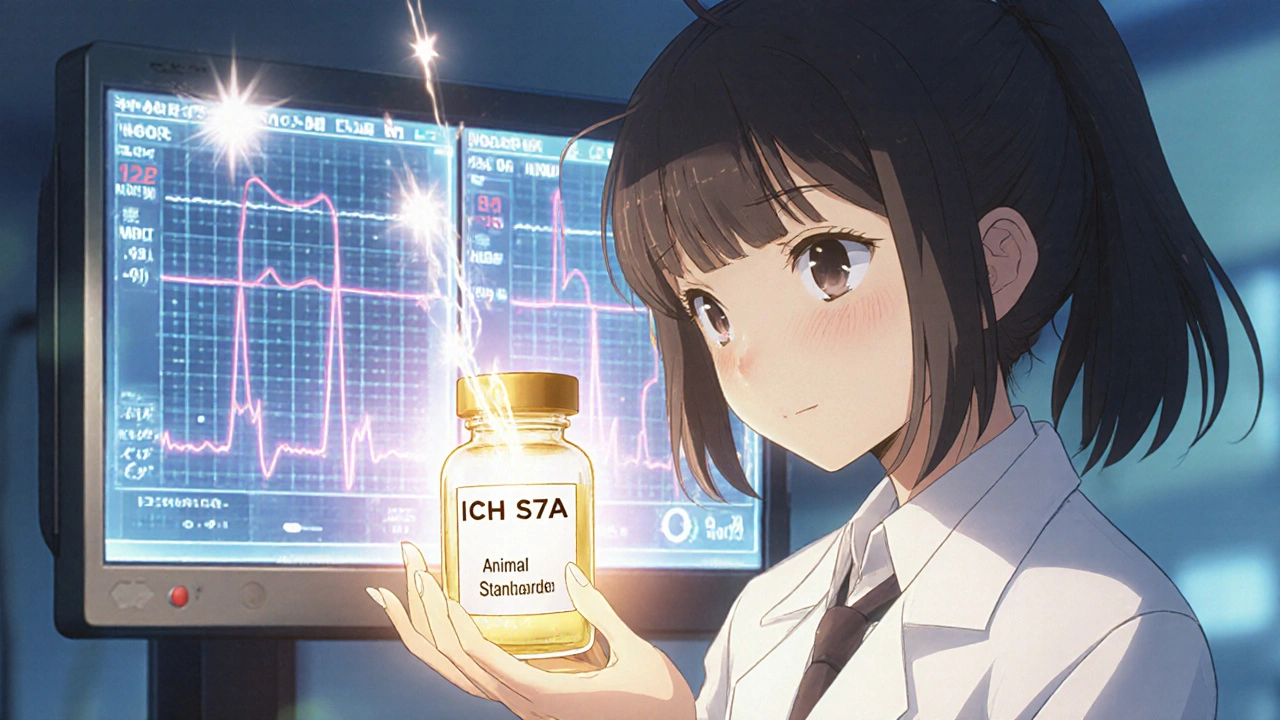International ICH Guidelines: How Global Harmonization Improves Medication Safety

ICH Guidelines Knowledge Quiz
Test Your Knowledge
How much do you know about the ICH guidelines that make global medicines safer and more accessible? This quiz will help you understand the key concepts and their real-world impact.
What does ICH stand for?
Which ICH guideline focuses specifically on heart safety testing for new drugs?
What is the primary benefit of ICH guidelines for patients?
How do ICH guidelines impact clinical trials?
What was the main problem with drug development before ICH guidelines were established?
Results
Every pill you take, every vaccine you receive, every cancer drug that gives someone a second chance - it didn’t just appear on shelves. It passed through a global system designed to make sure it’s safe, effective, and consistent no matter where you live. That system is the ICH guidelines.
What Are the ICH Guidelines?
The International Council for Harmonisation of Technical Requirements for Pharmaceuticals for Human Use (ICH) isn’t a government agency. It’s a unique collaboration between regulators and drug companies from the U.S., Europe, Japan, and now over 20 other countries. Founded in 1990, it became a formal legal entity under Swiss law in 2015. Its goal? Cut through the noise. Before ICH, a drug company might have to run three different sets of clinical trials - one for the U.S., one for Europe, one for Japan - just because each region had different rules. That meant delays, higher costs, and sometimes unnecessary animal testing or patient exposure.
ICH changed that. It created one set of science-based standards everyone agrees on. Today, there are over 60 finalized guidelines covering every stage of drug development - from how to test a new molecule in a lab to how to report side effects after the drug hits the market. These are grouped into four areas: Quality (Q), Safety (S), Efficacy (E), and Multidisciplinary (M). You don’t need to memorize them all, but you should know the big ones.
How ICH Keeps Medication Safe
Safety isn’t an afterthought in ICH - it’s built in from day one. Take ICH S1, the guideline on carcinogenicity testing. Before this, countries used different animal studies to check if a drug could cause cancer. Some required two-year rodent studies. Others didn’t. ICH S1, adopted in 2000, standardized what tests are needed, how long they run, and how to interpret results. That meant fewer animals used, faster approvals, and more confidence in the data.
Then there’s ICH S9, which addresses cancer drugs - a tricky category because they’re often toxic by design. Traditional safety rules didn’t fit. ICH S9 gave regulators and companies a clear path: focus on patient benefit, use targeted safety monitoring, and avoid blanket requirements that don’t apply. This helped get life-saving cancer therapies to patients faster without cutting corners on safety.
Another key player is ICH S7A and S7B, which deal with heart safety. These guidelines require new drugs to be tested for their potential to cause a dangerous heart rhythm called QT prolongation. Before these rules, some drugs were pulled from the market years after launch because they caused unexpected heart problems. Now, that risk is screened early - saving lives and avoiding costly recalls.
The Backbone of Clinical Trials: ICH E6
If you’ve ever participated in a clinical trial, you’ve been protected by ICH E6 (Good Clinical Practice). This isn’t just a suggestion - it’s the global gold standard for how trials are designed, conducted, recorded, and reported. It covers everything: informed consent, data integrity, site inspections, and how to handle adverse events.
Before ICH E6, a trial in Germany might have had different documentation rules than one in Brazil. That made it hard for regulators to trust the data. ICH E6 changed that. Now, no matter where a trial is run, the same rules apply. Regulatory agencies like the FDA and EMA can review data from anywhere in the world with confidence. That’s why global trials are common today - companies can recruit patients across continents and still meet one unified standard.

Real-World Evidence and the Future of ICH
ICH isn’t stuck in the past. In June 2024, it released a major update: a reflection paper on real-world evidence. This is a big deal. For decades, regulators relied only on tightly controlled clinical trials. But those trials often exclude older patients, people with multiple conditions, or those from diverse backgrounds. Real-world evidence comes from electronic health records, insurance claims, patient registries - data collected during normal medical care.
ICH’s new guidance helps standardize how this data is collected, analyzed, and used to support regulatory decisions. Imagine a drug approved for arthritis. Instead of waiting five more years for a new trial, regulators can now use real-world data from millions of patients to confirm it’s safe for elderly users with kidney disease. That’s faster access, smarter decisions, and better outcomes.
How ICH Is Adopted Around the World
ICH guidelines don’t become law automatically. They go through a five-step process: idea → expert draft → public comment → regulatory approval → implementation. Once a guideline reaches Step 4, member agencies like the FDA, EMA, or UK’s MHRA adopt it as their own rule.
The U.S. FDA implements every ICH guideline as official guidance. That means if you’re a drug company selling in America, you have to follow it - no exceptions. The European Medicines Agency does the same. The UK, even after Brexit, joined ICH as a full member in 2022. Why? Because it’s more efficient. Following ICH means companies don’t need to repackage data for each market. It saves time, money, and lives.
Even countries not in ICH often mirror its guidelines because they’re the global benchmark. India, Brazil, Canada, Australia - they all use ICH as a reference. It’s not about politics. It’s about science.

Why ICH Matters to You
You might think, “I’m not a scientist. Why should I care?” Here’s the truth: ICH is why your prescription is the same brand everywhere. Why new drugs reach you faster. Why side effects are caught earlier. Why a drug tested in Tokyo is trusted in Pittsburgh.
Before ICH, a new diabetes drug might have taken 10 years to reach patients in all major markets. Today, it’s often 5-7 years. That’s because one set of rules replaces three. Fewer duplicate trials mean fewer people exposed to experimental drugs unnecessarily. Fewer animal tests mean more ethical science. And fewer regulatory roadblocks mean more innovation - including for rare diseases that otherwise wouldn’t be profitable to develop.
ICH also helps with generics. Take ICH M13A, the new 2024 guideline on bioequivalence for oral pills. It tells manufacturers exactly how to prove their generic version works the same as the brand-name drug. That means more affordable options reach patients faster - without risking safety.
Challenges and What’s Next
ICH isn’t perfect. The process can be slow. A new guideline can take 5-7 years to go from idea to global implementation. Emerging therapies - like gene editing, mRNA vaccines, or AI-driven drug discovery - are moving faster than the guidelines can adapt. Some experts worry ICH is catching up, not leading.
But the organization is responding. It’s created special working groups for advanced therapies. It’s increasing transparency by publishing public consultation drafts online. And it’s partnering with groups like the International Coalition of Medicines Regulatory Authorities (ICMRA) to stay ahead of trends.
The real test? Can ICH keep its science-driven, consensus-based model alive as more countries join and political pressures rise? So far, yes. Because the benefits are too clear: safer medicines, faster access, less waste, and more trust.
Where to Learn More
If you’re a patient, you don’t need to dig into the documents. But if you’re a student, researcher, or someone working in healthcare, the official ICH website (ich.org) has all guidelines, training materials, and implementation status. The FDA and EMA also publish their own versions with local context. Start with ICH E6 or ICH S1 - they’re the foundation.
One thing’s certain: medication safety isn’t a local issue anymore. It’s a global one. And ICH is the quiet engine making sure it works - for everyone, everywhere.
What does ICH stand for?
ICH stands for the International Council for Harmonisation of Technical Requirements for Pharmaceuticals for Human Use. It’s a global organization that brings together regulatory agencies and pharmaceutical companies to create unified standards for drug development and safety.
Are ICH guidelines mandatory?
ICH guidelines aren’t laws themselves, but once adopted by a regulatory agency like the FDA or EMA, they become mandatory for companies seeking approval in that region. So while the guidelines are voluntary at the ICH level, compliance is required in practice.
How do ICH guidelines improve drug safety?
ICH guidelines standardize testing methods for risks like cancer, heart toxicity, and birth defects. This ensures drugs are evaluated the same way everywhere, reducing gaps in safety data. For example, ICH S7A/S7B require all new drugs to be tested for heart rhythm risks, preventing dangerous side effects from being missed.
What’s the difference between ICH and FDA guidelines?
The FDA implements ICH guidelines as its own official guidance. So FDA guidelines on clinical trials, safety testing, or data reporting are often identical to ICH standards. ICH creates the global template; the FDA enforces it locally.
How often are ICH guidelines updated?
ICH guidelines are updated as science evolves. The process includes public consultation, expert review, and regulatory approval. Major updates happen every few years - for example, ICH M13A on bioequivalence was finalized in 2024. Some guidelines, like ICH E6, are routinely revised to reflect new technologies and practices.
Can countries outside the U.S., EU, and Japan join ICH?
Yes. Since becoming a legal entity in 2015, ICH has expanded to include regulatory authorities from Canada, Australia, Switzerland, South Korea, Brazil, Singapore, and others. The UK joined as a full member in 2022. Any national regulatory body can apply for membership if it meets ICH’s technical and governance requirements.





Robert Merril
November 17, 2025 AT 05:11ICH my ass they just want big pharma to stop wasting money on redundant tests so they can charge more for the same pills
Georgia Green
November 18, 2025 AT 17:06i read the s7a/s7b doc last week and honestly it’s a game changer. finally someone standardized cardiac safety testing. used to be a wild west out there
Kathy Grant
November 19, 2025 AT 01:01It’s quiet but it’s everything. Every time someone gets a new cancer drug before they’re too far gone, or a kid gets a safe vaccine without a three-year wait - it’s because of these guidelines. No fanfare. No headlines. Just science working the way it should. I think about that every time I fill a prescription. It’s not glamorous, but it’s sacred.
Christina Abellar
November 20, 2025 AT 22:40Exactly. ICH makes global health possible.
Eva Vega
November 21, 2025 AT 08:58The harmonization of bioequivalence protocols under ICH M13A represents a paradigmatic shift in the regulatory pharmacokinetic evaluation of generic oral solid dosage forms, enabling cross-jurisdictional comparability without compromising therapeutic equivalence thresholds.
Dave Feland
November 22, 2025 AT 14:50They say ICH is about science but let’s be real - it’s a cartel. The same 12 big pharma execs sit on every working group. They write the rules, then sell you the drugs. And now they want to use real-world data? That’s just a backdoor to skip clinical trials. Your EHR isn’t a clinical trial. It’s a mess of billing codes and incomplete records. Don’t be fooled.
Ashley Unknown
November 24, 2025 AT 13:34Oh so now you trust the FDA and EMA? What about the 2008 Vioxx scandal? The 2011 Avandia cover-up? The 2019 Zantac recall? ICH doesn’t prevent disasters - it just makes them look official. They delay generics so the brand-name companies can keep raking in billions. And now they’re pushing real-world data? That’s how they bury adverse events in noise. They don’t want safety - they want liability protection disguised as science. Wake up. This is corporate control wrapped in a lab coat.
Roberta Colombin
November 26, 2025 AT 07:23Everyone deserves safe medicine, no matter where they live. ICH helps make that real. It’s not perfect, but it’s the best we’ve got. We should be helping more countries join, not doubting it. Science should belong to everyone.
Noel Molina Mattinez
November 28, 2025 AT 02:09ICH is why my grandma got her Alzheimer’s drug in 2021 instead of 2026. No one talks about this but it saves lives every day. I’m not a scientist but I know this matters